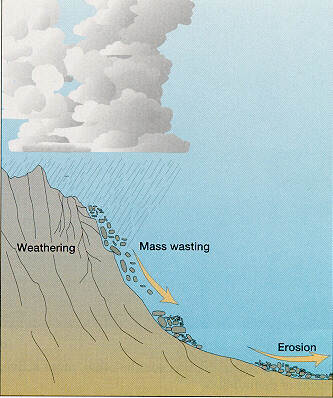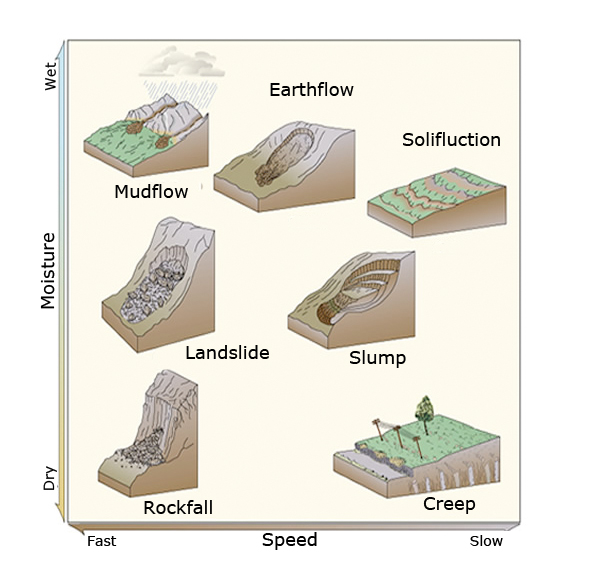EXPLORATION: Weathering and Erosion
3. Mass Movement
Mass movement, also called Mass Wasting, includes bulk movements of soil and rock debris down slopes in response to the pull of gravity, or the rapid or gradual sinking of the Earth’s ground surface in a predominantly vertical direction. Formerly, the term mass wasting referred to a variety of processes by which large masses of crustal materials are moved by gravity from one place to another.
More recently, the term mass movement has been substituted to include mass wasting processes and the sinking of confined areas of the Earth’s ground surface. Mass movements on slopes and sinking mass movements are often aided by water and the significance of both types is the part each plays in the alteration of landforms.
The variety of downslope mass movements reflects the diversity of factors that are responsible for their origin. Such factors include: weathering or erosional debris cover on slopes, which is usually liable to mass movement; the character and structure of rocks, such as resistant permeable beds prone to sliding because of underlying impermeable rocks; the removal of the vegetation cover, which increases the slope’s susceptibility to mass movement by reducing its stability; artificial or natural increases in the slope’s steepness, which will usually induce mass movement; earthquaketremors, which affect the slope equilibrium and increase the likelihood of mass movement; and flowing ground water, which exerts pressure on soil particles and impairs slope stability. These factors affecting slope conditions will often combine with climatic factors such as precipitation and frost activity to produce downslope mass movement.
The types of mass movements caused by the above factors include: the abrupt movement and free fall of loosened blocks of solid rock, known as rockfalls; several types of almost imperceptible downslope movement of soil particles and rock debris, collectively called creep; the subsurface creep of rock material, known as bulging: and the multiplicity of downslope movements of bedrock and other debris caused by the separation of a slope section along a plane of least resistance or slip surface, collectively called landslides.
Text above from Britannica - Mass Movement
 |
|
Types of mass wasting

Courtesy: University of Texas
Talus Slope
A collection of angular rock fragments at the base of a cliff is called a talus slope which is made of scree. Watch the short video below which analyzes a talus slope made of scree.